![[Previous]](../../../buttons/fprev.png)
![[Next]](../../../buttons/fnext.png)
DTC C1032: Abnormality
in RR wheel speed sensor signal
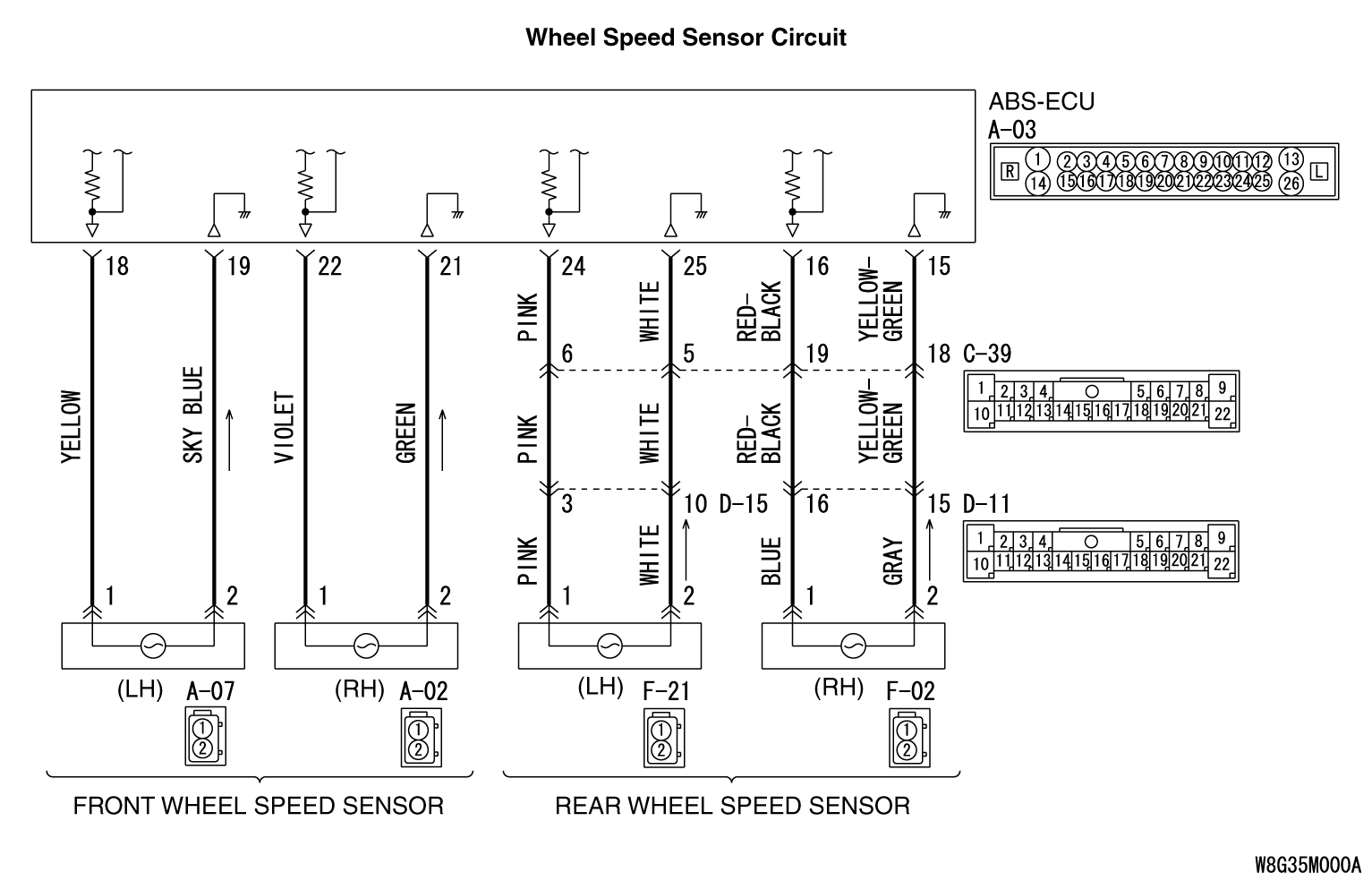
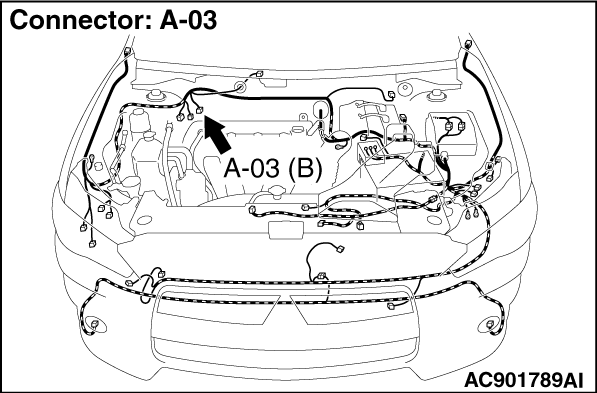
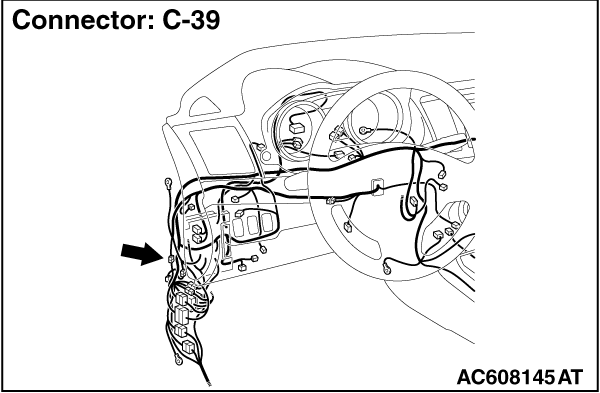
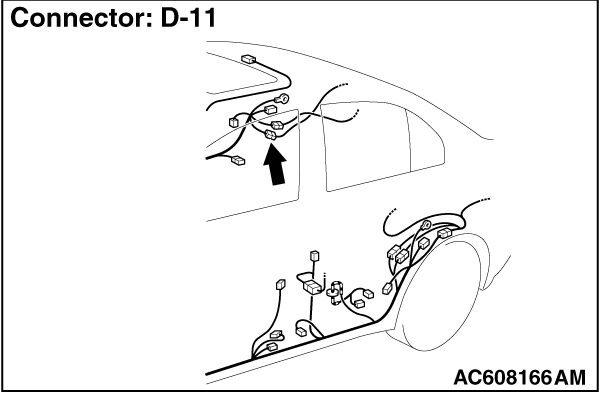
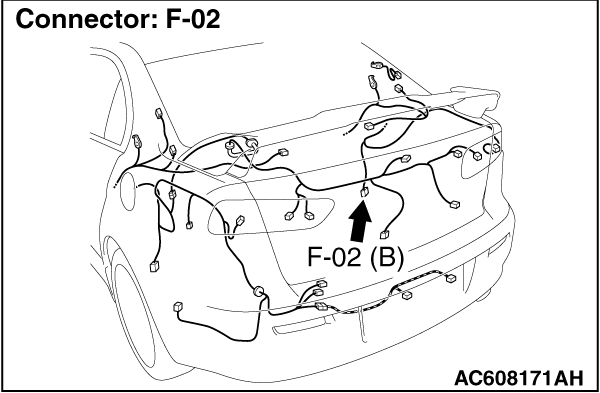
|
|
| caution |
- If there is
any problem in the CAN bus lines, an incorrect DTC may be set. Prior to this diagnosis, diagnose
the CAN bus lines (Refer to GROUP 54C - CAN Bus Line Diagnostic Flow
 ). ).
- Whenever ECU is replaced, ensure that the CAN bus lines are normal.
|
|
|
|
- The wheel speed sensor is a kind of a pulse generator. It consists of encoders
(a plate on which north and south pole sides of the magnets are arranged alternately) for detecting the
wheel speed which rotates at the same speed of the wheels and wheel speed sensors. This sensor
outputs frequency pulse signals in proportion to the wheel speed.
- The pulse signals, which the wheel speed sensor creates, are sent to ABS-ECU. ABS-ECU
uses the frequency of the pulse signals to determine the wheel speed.
|
|
|
ABS-ECU monitors the signals from each wheel speed sensor while the vehicle is being driven.
If any fault below is found in these sensor signals, ABS-ECU will set the relevant DTC.
|
|
|
- Irregular change in the wheel speed sensor signal
- Wheel speed sensor signal continuously indicates high value.
|
|
|
Current trouble
- Excessive gap between the wheel speed sensor and the magnetic encoder for wheel
speed detection
- Adhesion of foreign materials on the wheel speed sensor
- Adhesion of foreign materials on the magnetic encoder for wheel speed detection
- Wheel bearing malfunction
- Malfunction of wheel speed sensor
- Damaged wiring harness and connectors
- External noise interference
- Improper installation of the wheel speed sensor
- Deformation of the magnetic encoder for wheel speed detection
- Malfunction of ABS-ECU
- Disturbance of magnetization pattern for magnetic encoder for wheel speed detection
- The number of poles on the magnetic encoder for wheel speed detection (the number
of N-pole and S-pole) is changed.
|
|
|
Past trouble
- When the DTC C102B is also set, carry out diagnosis with particular
emphasis on wiring harness and connector failures between ABS-ECU and the wheel speed sensor. For
diagnosis procedures, refer to How to treat past trouble (Refer to GROUP 00 - How to
Use Troubleshooting/How to Treat Past Trouble
 ). ).
- When the DTC C102B is not set, the following conditions may be present:
- Some wheels slip
- Unstable vehicle attitude
- External noise interference
- Vehicle ran with the parking brake applied.
|
|
|
Required Special Tools:
- MB991958: Scan Tool (M.U.T.-III Sub Assembly)
- MB991824: Vehicle Communication Interface (V.C.I.)
- MB991827: M.U.T.-III USB Cable
- MB991910: M.U.T.-III Main Harness A
|
|
|
STEP 1. Using scan tool MB991958, diagnose the CAN bus lines.
|
|
|
Use scan tool to diagnose the CAN bus lines.
|
|
|
Q.
Is the check result normal?
|
|
|
 Go to Step 3. Go to Step 3.
|
|
|
|
|
|
 Repair the CAN bus lines (Refer to GROUP 54C - CAN Bus Diagnostics Table Repair the CAN bus lines (Refer to GROUP 54C - CAN Bus Diagnostics Table  ).
On completion, go to Step 2. ).
On completion, go to Step 2.
|
|
|
|
|
|
STEP 2. DTC recheck after resetting CAN bus lines
|
|
|
 Go to Step 3. Go to Step 3.
|
|
|
|
|
|
 The procedure is complete. The procedure is complete.
|
|
|
|
|
|
STEP 3. Using scan tool MB991958, check the DTC
|
|
|
Check that the DTC C102B is also set.
|
|
|
Q.
Is DTC C102B also set?
|
|
|
 Perform the diagnosis for the DTC C102B (Refer to Perform the diagnosis for the DTC C102B (Refer to  ). ).
|
|
|
|
|
|
 Go to Step 4. Go to Step 4.
|
|
|
|
|
|
STEP 4. Connector check: A-03 ABS-ECU connector, C-39 and D-11 intermediate
connector, F-02 rear wheel speed sensor (RH) connector
|
|
|
Q.
Is the check result normal?
|
|
|
 Go to Step 5. Go to Step 5.
|
|
|
|
|
|
 Repair the defective connector. Then go to Step 12. Repair the defective connector. Then go to Step 12.
|
|
|
|
|
|
STEP 5. Wiring harness check between A-03 ABS-ECU connector terminal
No.16 and F-02 rear wheel speed sensor (RH) connector terminal No.1, and between A-03 ABS-ECU
connector terminal No.15 and F-02 wheel speed sensor connector terminal No.2.
|
|
|
Q.
Is the check result normal?
|
|
|
 Go to Step 6. Go to Step 6.
|
|
|
|
|
|
 Repair the wiring harness. Then go to Step 12. Repair the wiring harness. Then go to Step 12.
|
|
|
|
|
|
STEP 6. Check wheel speed sensor <RR> installation
|
|
|
Check how the wheel speed sensor <RR> is installed (Disconnection of
wheel speed sensor <RR>, loose mounting bolt, etc.).
|
|
|
Q.
Is the check result normal?
|
|
|
 Go to Step 7. Go to Step 7.
|
|
|
|
|
|
 Reinstall the wheel speed sensor <RR> correctly (Refer to Reinstall the wheel speed sensor <RR> correctly (Refer to  ).
Then go to Step 7. ).
Then go to Step 7.
|
|
|
|
|
|
STEP 7. Check for wheel speed sensor <RR> output
current
|
|
|
Refer to  . .
|
|
|
Q.
Is the check result normal?
|
|
|
 Go to Step 8. Go to Step 8.
|
|
|
|
|
|
 Replace the wheel speed sensor <RR> (Refer to Replace the wheel speed sensor <RR> (Refer to  ). Then
go to Step 11. ). Then
go to Step 11.
|
|
|
|
|
|
STEP 8. Check for wheel bearing looseness
|
|
|
| note |
- Loose wheel bearing may increase the gap between the wheel speed sensor <RR> and
the wheel speed detection magnet encoder.
- Check the wheel bearing <RR> for looseness (Refer to GROUP 27A - On-vehicle
Service
 ). ).
|
|
|
|
Q.
Is the check result normal?
|
|
|
 Go to Step 9. Go to Step 9.
|
|
|
|
|
|
 Replace the rear wheel hub assembly <RR> (Refer to GROUP 27A - Rear
Axle Hub Assembly Replace the rear wheel hub assembly <RR> (Refer to GROUP 27A - Rear
Axle Hub Assembly  ). Then go to Step 12. ). Then go to Step 12.
|
|
|
|
|
|
STEP 9. Check wheel speed detection encoder
|
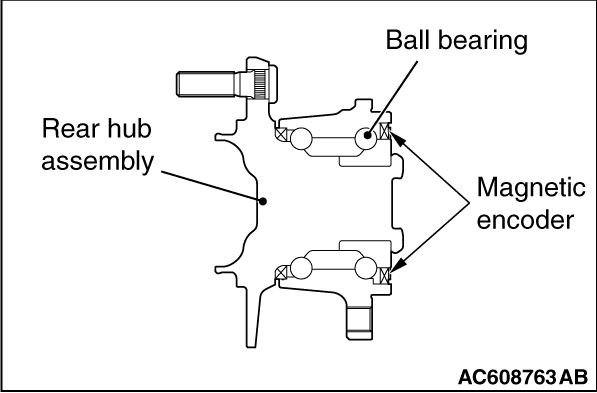
|
Check the encoder for adhesion of foreign materials or deformation.
Q.
Is the check result normal?
 Go to Step 10. Go to Step 10.
NO (Adhesion of foreign materials) : Remove the foreign materials and clean the encoder so as not to disturb the magnetization
pattern on it while taking care of the magnet, magnetic substance, and magnetic attraction.
Then go to Step 12. : Remove the foreign materials and clean the encoder so as not to disturb the magnetization
pattern on it while taking care of the magnet, magnetic substance, and magnetic attraction.
Then go to Step 12.
NO (Deformation) : Replace the rear wheel hub assembly <RR> (Refer to GROUP 27A - Rear Axle
Hub Assembly : Replace the rear wheel hub assembly <RR> (Refer to GROUP 27A - Rear Axle
Hub Assembly  ). Then go to Step 12. ). Then go to Step 12.
|
|
|
STEP 10. Check whether the DTC is reset.
|
|
|
(2)Drive the vehicle at 12mph (20 km/h) or higher.
| note |
The ABS warning light does not turn OFF in some cases unless the vehicle runs at 12mph
(20 km/h) or higher.
|
|
|
|
 Replace the wheel speed sensor <RR> (Refer to Replace the wheel speed sensor <RR> (Refer to  ).
Then go to Step 11. ).
Then go to Step 11.
|
|
|
|
|
|
 Intermittent malfunction (Refer to GROUP 00 - How to Use Troubleshooting/How
to Cope with Intermittent Malfunctions Intermittent malfunction (Refer to GROUP 00 - How to Use Troubleshooting/How
to Cope with Intermittent Malfunctions ). ).
|
|
|
|
|
|
STEP 11. Check whether the DTC is reset.
|
|
|
(2)Drive the vehicle at 12mph (20 km/h) or higher.
| note |
The ABS warning light does not turn OFF in some cases unless the vehicle runs at 12mph
(20 km/h) or higher.
|
|
|
|
 Replace the hydraulic unit (integrated with ABS-ECU) (Refer to Replace the hydraulic unit (integrated with ABS-ECU) (Refer to  ).
Then go to Step 12. ).
Then go to Step 12.
|
|
|
|
|
|
 The procedure is complete. The procedure is complete.
|
|
|
|
|
|
STEP 12. Check whether the DTC is reset.
|
|
|
(2)Drive the vehicle at 12mph (20 km/h) or higher.
| note |
The ABS warning light does not turn OFF in some cases unless the vehicle runs at 12mph
(20 km/h) or higher.
|
|
|
|
 Return to Step 1. Return to Step 1.
|
|
|
|
|
|
 The procedure is complete. The procedure is complete.
|
|
|
|
![[Previous]](../../../buttons/fprev.png)
![[Next]](../../../buttons/fnext.png)





 Go to Step 3.
Go to Step 3. Repair the CAN bus lines (Refer to GROUP 54C - CAN Bus Diagnostics Table
Repair the CAN bus lines (Refer to GROUP 54C - CAN Bus Diagnostics Table  ).
On completion, go to Step 2.
).
On completion, go to Step 2. Go to Step 3.
Go to Step 3. The procedure is complete.
The procedure is complete. Perform the diagnosis for the DTC C102B (Refer to
Perform the diagnosis for the DTC C102B (Refer to  ).
). Go to Step 4.
Go to Step 4. Go to Step 5.
Go to Step 5. Repair the defective connector. Then go to Step 12.
Repair the defective connector. Then go to Step 12. Go to Step 6.
Go to Step 6. Repair the wiring harness. Then go to Step 12.
Repair the wiring harness. Then go to Step 12. Go to Step 7.
Go to Step 7. Reinstall the wheel speed sensor <RR> correctly (Refer to
Reinstall the wheel speed sensor <RR> correctly (Refer to  ).
Then go to Step 7.
).
Then go to Step 7. .
. Go to Step 8.
Go to Step 8. Replace the wheel speed sensor <RR> (Refer to
Replace the wheel speed sensor <RR> (Refer to  ). Then
go to Step 11.
). Then
go to Step 11. Go to Step 9.
Go to Step 9. Replace the rear wheel hub assembly <RR> (Refer to GROUP 27A - Rear
Axle Hub Assembly
Replace the rear wheel hub assembly <RR> (Refer to GROUP 27A - Rear
Axle Hub Assembly  ). Then go to Step 12.
). Then go to Step 12. Replace the wheel speed sensor <RR> (Refer to
Replace the wheel speed sensor <RR> (Refer to  ).
Then go to Step 11.
).
Then go to Step 11. Intermittent malfunction (Refer to GROUP 00 - How to Use Troubleshooting/How
to Cope with Intermittent Malfunctions
Intermittent malfunction (Refer to GROUP 00 - How to Use Troubleshooting/How
to Cope with Intermittent Malfunctions ).
). Replace the hydraulic unit (integrated with ABS-ECU) (Refer to
Replace the hydraulic unit (integrated with ABS-ECU) (Refer to  ).
Then go to Step 12.
).
Then go to Step 12. The procedure is complete.
The procedure is complete. Return to Step 1.
Return to Step 1. The procedure is complete.
The procedure is complete.